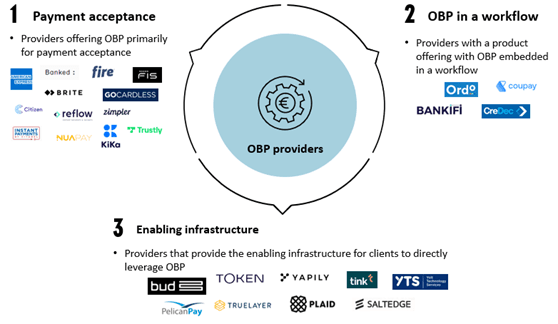オープンバンキング決済 (OBP) は決済業界で最もホットなテーマの1つである。既存の決済フローに破壊的変化をもたらす可能性に加え、決済開始APIが多くの非効率な決済エクスペリエンスを変えるユースケースにも関心が高まっている。現在、複数の市場ではOBPを実現するインフラが整備されており、決済業界は今こそOBPを活用すべき時である。
オープンバンキング決済 (OBP) は新しい概念というわけではなく、APIを介して決済を開始するというアイデアでもない。2018年にPSD2 (欧州決済サービス指令第2版) によってOBPの新たな展望がもたらされたことにより、OBPが決済市場のいくつかの領域に破壊的変化をもたらす可能性について大きな反響があった。
しかし、当時はこれを実現するためのインフラはまだ整備されておらず、OBPはほとんど注目されなくなっていった。その間により明確な基準が構築され、これを実現するためのサービス (APIの集約など) を提供するプロバイダーが成長したことで、銀行、アクワイアラー、およびより広範な決済バリューチェーンにとって、OBPは実行可能な提案となった。
本レポートでは、2つのテーマを詳細に検証する。1つ目は、OBPを実現するインフラが、多くの市場でOBPをどの程度支援できるようになっているのかということである。現在は、決済開始APIの品質と可用性の改善に加え、サービスプロバイダーとベンダーのより広範なエコシステムも急速に拡大している。

(注: 上記の表に記載されている会社名は全てを網羅したものではない)
2つ目のテーマは、OBPの新たなユースケースであり、現在の金融機関によるOBPの活用方法を中心に検証する。レポートの最後では、最も重要な点として、将来的に銀行がイノベーションを起こすべき分野についての評価を行っている。
様々な新規参入者によって決済業界での牽引力をかなり奪われてきた銀行にとって、OBPはイノベーションを推進し、市場シェアを拡大する重要な機会になる。OBP市場はまだ初期段階にあるが、銀行はこの機会を積極的に掴みに行くべきである。
OBPの概念の詳細については、セレントのレポート「オープンバンキング決済への偏見を取り除く:入門編」を参照されたい。
本レポートで取り上げた銀行は次の通り:American Express、BNP Paribas、HSBC、Lloyds、NatWest、Tesco Bank、The Co-Operative Bank
本レポートで取り上げたTPPとベンダーは次の通り:Banked、Bankifi、Brite、Bud、Citadel、Citizen、Coupay、CreDec、Ecospend、Endava、Fire、FIS、GoCardless、KiKa、Konsentus、Moneyhub、Nuapay、Ordo、PelicanPay、Plaid、Pollinate、Reflow、Revolut、Salt Edge、Streeva、Tink、Token、Truelayer、Trustly、Yapily、Yolt、Zimpler。






